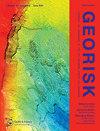2014年俄罗斯远东堪察加半岛间歇泉谷滑坡覆盖区域的地热爆炸
IF 4.8
3区 工程技术
Q1 ENGINEERING, GEOLOGICAL
Georisk-Assessment and Management of Risk for Engineered Systems and Geohazards
Pub Date : 2023-03-10
DOI:10.3390/geohazards4010005
引用次数: 0
摘要
间歇泉地热田是风景秀丽的火山地貌,通常包含数十到数百个热点喷口,这些喷口喷出沸水或含有冒泡的泥池。由于沸水温度、喷口位置和喷发动力学的变化,这些领域是潜在的危险场所,人们对这些都知之甚少。在这里,我们报道了快速而深刻的变化,这些变化可能会影响到这样一个间歇泉场,并最终导致危险的、意想不到的喷发。我们研究了堪察加半岛的间歇泉谷,这是一个间歇泉和其他热特征和沸腾池的领域。2018年和2019年,我们利用高分辨率三立体卫星数据和带有光学和热红外摄像机的无人机系统(UAS),确定了一个新出现的爆炸地点。对爆炸前后获得的数据进行结构-运动分析,揭示了新喷口的形态和热细节。爆炸现场产生了一个超过150立方米的爆炸再沉积砾石和粘土的光圈区,一个直径7.5米的略椭圆形陨石坑,陨石坑边缘高0.30米。然而,与摄影测量数据档案的比较表明,这个地点在几年前就有热活动,并且包含一个被山体滑坡和河流沉积物遮蔽和覆盖的陨石坑。这些结果使我们能够建立一个概念模型,并突出了滑坡和碎屑沉积物埋藏的热特征的潜在危害。其他地方的类似地点也可能发生突然爆炸,这突出表明需要仔细评估和监测其他地区间歇泉地点的地貌和水文变化。本文章由计算机程序翻译,如有差异,请以英文原文为准。
Geothermal Explosion at the 2014 Landslide-Covered Area of the Geyser Valley, Kamchatka, Russian Far East
Geyser geothermal fields are scenic volcanic landforms that often contain tens to hundreds of thermal spot vents that erupt boiling water or contain bubbling mud pools. The fields are potentially hazardous sites due to boiling water temperatures and changes in vent locations and eruption dynamics, which are poorly understood. Here we report on the rapid and profound changes that can affect such a geyser field and ultimately lead to a dangerous, unanticipated eruption. We studied the Geyser Valley, Kamchatka Peninsula, which is a field of geysers and other thermal features and boiling pools. Using high-resolution tri-stereo satellite data and unmanned aerial systems (UAS) with optical and thermal infrared cameras in 2018 and 2019, we were able to identify a newly emerging explosion site. Structure-from-motion analysis of data acquired before and after the explosion reveals morphological and thermal details of the new vent. The explosion site produced an aureole zone of more than 150 m3 of explosively redeposited gravel and clay, a slightly elliptical crater with a diameter of 7.5 m and a crater rim 0.30 m high. However, comparison with archives of photogrammetric data suggests that this site was thermally active years earlier and contained a crater that was obscured and covered by landslides and river sediments. The results allow us to develop a conceptual model and highlight the hazard potential of thermal features buried by landslides and clastic deposits. Sudden explosions may occur at similar sites elsewhere, highlighting the need for careful assessment and monitoring of geomorphological and hydrological changes at geyser sites in other regions.
求助全文
通过发布文献求助,成功后即可免费获取论文全文。
去求助
来源期刊
CiteScore
8.70
自引率
10.40%
发文量
31
期刊介绍:
Georisk covers many diversified but interlinked areas of active research and practice, such as geohazards (earthquakes, landslides, avalanches, rockfalls, tsunamis, etc.), safety of engineered systems (dams, buildings, offshore structures, lifelines, etc.), environmental risk, seismic risk, reliability-based design and code calibration, geostatistics, decision analyses, structural reliability, maintenance and life cycle performance, risk and vulnerability, hazard mapping, loss assessment (economic, social, environmental, etc.), GIS databases, remote sensing, and many other related disciplines. The underlying theme is that uncertainties associated with geomaterials (soils, rocks), geologic processes, and possible subsequent treatments, are usually large and complex and these uncertainties play an indispensable role in the risk assessment and management of engineered and natural systems. Significant theoretical and practical challenges remain on quantifying these uncertainties and developing defensible risk management methodologies that are acceptable to decision makers and stakeholders. Many opportunities to leverage on the rapid advancement in Bayesian analysis, machine learning, artificial intelligence, and other data-driven methods also exist, which can greatly enhance our decision-making abilities. The basic goal of this international peer-reviewed journal is to provide a multi-disciplinary scientific forum for cross fertilization of ideas between interested parties working on various aspects of georisk to advance the state-of-the-art and the state-of-the-practice.

 求助内容:
求助内容: 应助结果提醒方式:
应助结果提醒方式:


